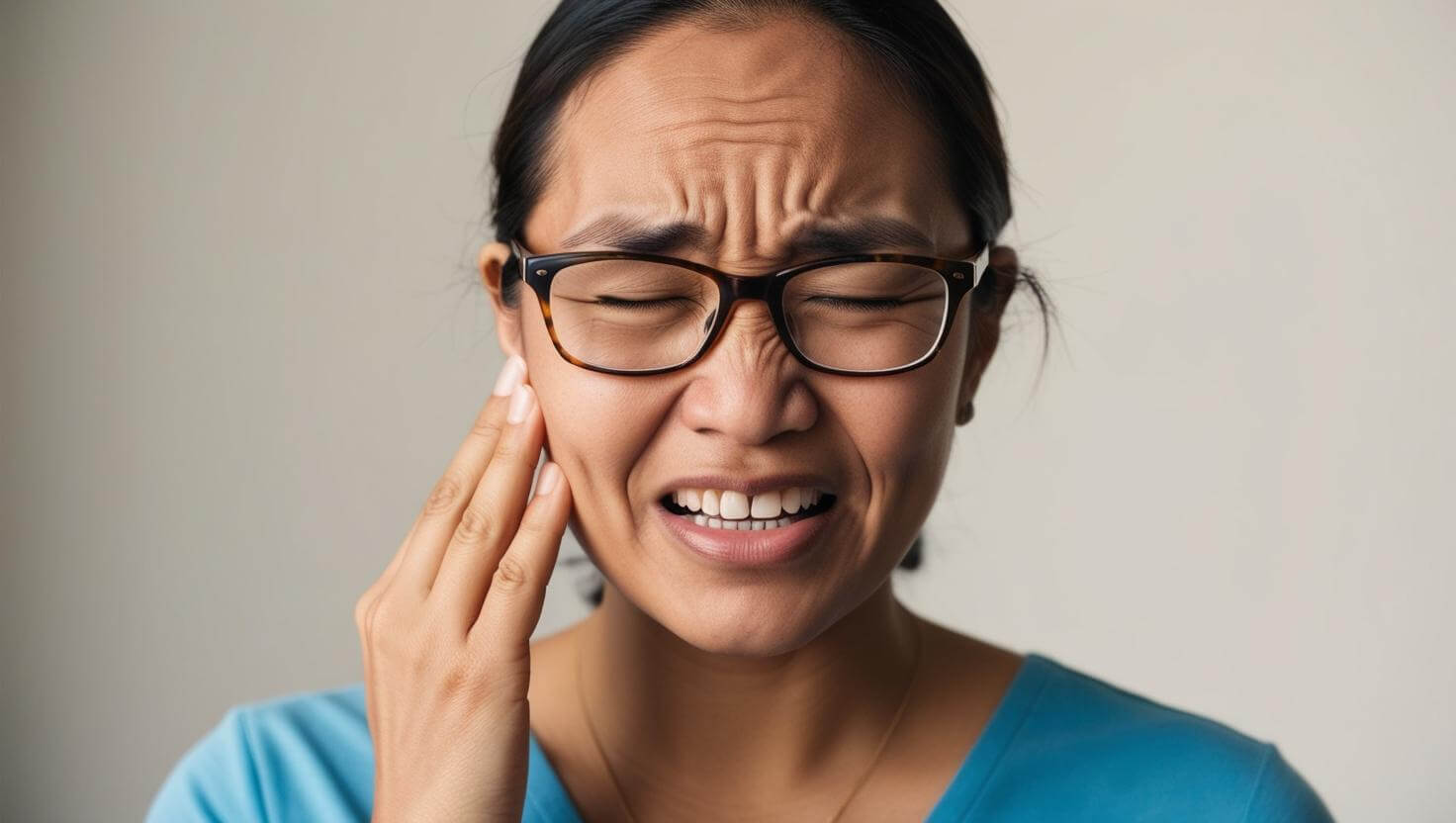The temporomandibular joint connects your mandible, or lower jaw bone, to the temporal bones on either side of the skull and is primarily responsible for the movement needed to chew, speak, and yawn. Arthritic conditions, injuries, and behaviors like teeth grinding, or bruxism, can lead to lasting TMJ disorders that can cause jaw pain, limit movement, and create noises like clicking or popping. However, can TMJ cause ear pain or neck pain, too?
Does TMJ Cause Ear Pain?
TMJ disorders can indeed cause ear pain due to the close anatomical and functional relationship between the TMJ and the ear structures. They both share a network of blood vessels and nerve pathways, particularly the trigeminal nerve, which supplies sensation to both the jaw and parts of the ear.
An inflamed or dysfunctional TMJ can send pain signals along these shared nerve pathways, leading to perceived ear pain, which is also known as referred pain.
Ear pain associated with the TMJ often presents with other manifestations, such as jaw pain, headaches, or facial discomfort. If the pain worsens with jaw movements like chewing, talking, or yawning, it may also point to a TMJ-related issue.
What Does TMJ Ear Pain Feel Like?
The nature of the pain depends on the type of Temporomandibular Disorder (TMD) and which tissues the disorder affects. For example, trigeminal nerve stimulation or sudden TMJ inflammation due to overuse or injury can cause sharp, stabbing ear pain.
Alternatively, persistent muscle tension related to habitual jaw clenching or bruxism can lead to dull, continuous pain in the ear. This persistent ache can also stem from ongoing inflammation and discomfort due to degenerative conditions that affect the TMJ, like arthritis.
How Do You Diagnose TMJ Ear Pain?
When orthodontists suspect that the TMJ is causing ear pain, they typically follow a comprehensive diagnostic process that includes:
- Medical history review to establish the nature of the ear pain and uncover accompanying TMD-related symptoms or habits
- Physical examination of the TMJ and surrounding muscles to identify tenderness, swelling, or abnormal movements, as well as unusual sounds
- Jaw function assessment to evaluate the range of motion of the jaw determines any limitations or deviations during opening and closing
Finally, a provider will perform a differential diagnosis to rule out other potential causes of ear pain, such as ear infections or neurological conditions.
How Do You Stop TJM Ear Pain?

There are widely recognized treatment methods designed to manage TMJ disorders and related ear pain. For instance, over-the-counter NSAIDs such as ibuprofen can help relieve inflammation and pain in the jaw and ear areas. If you tend to grind your teeth, wearing a mouthguard at night can help reduce strain on the TMJ.
Additionally, physical therapy that involves gentle jaw exercises and stretches can improve mobility and reduce muscle tension.
In cases where conservative treatments are insufficient, orthodontists may recommend prescription medications, custom-fitted oral appliances, or other interventions tailored to the individual’s specific condition.
Can TMJ Cause Neck Pain?
It’s common for problems with the TMJ to overuse muscles and cause tension in the neck. Habits like bruxism and clenching can strain the trapezius and sternocleidomastoid muscles around the joint. As a result, the interconnected muscles in the neck have to overcompensate. TMJ misalignment also produces an imbalance that can result in persistent discomfort in the cervical spine and the surrounding muscles.
Furthermore, the same trigeminal nerve pathway that the TMJ shares with the inner ear also extends down into the neck and out to the shoulders. Hence, TMJ disorders often send referred pain down into these regions, particularly on the left side.
There are specific symptoms that present when the TMJ causes neck pain, such as neck and shoulder stiffness. Since the nerves and muscles that connect to the TMJ also reach the cervical spine, pain that radiates from the neck to the jaw can be linked to TMDs as well.
What Does TMJ Neck Pain Feel Like?
When TMDs cause neck pain, it can feel like a dull ache or stiffness extending from the jaw area to the neck and shoulders. This discomfort may include muscle tenderness and limited range of motion in the neck. TMD-related headaches that originate from the top of the neck are often described as a steady throbbing that mimics tension-type headaches or migraines. It’s also important to note that neck pain due to TMDs can vary in intensity and may be intermittent or constant, depending on the severity of the disorder.
How Does a TMJ Neck Pain Evaluation Work?

To diagnose TMJ-related neck pain, orthodontists typically begin by examining the jaw and neck muscles through palpation, checking for signs of tenderness, stiffness, or swelling. They also observe jaw movements, asking patients to open and close their mouths to assess for clicking, popping, or restricted movement. The evaluation also looks at posture, as poor alignment can contribute to or worsen TMJ symptoms.
Imaging tools can not only confirm that a TMJ disorder is the source of neck pain but also rule out other potential causes. MRIs can detect issues in the soft tissues around the TMJ, such as disc displacement or inflammation. CT scans offer detailed images of bone structures, revealing any abnormalities in the jaw or cervical spine, while X-rays can identify joint-related problems like arthritis.
Does TMJ Neck Pain Go Away?
The duration of neck pain caused by TMJ disorders varies among individuals and depends on several factors. For example, poor forward head posture places extra strain on the neck and jaw muscles, creating a cycle of pain that can make TMD symptoms worse. Furthermore, habits like bruxism and jaw clenching will also contribute to neck discomfort if they aren’t controlled.
However, appropriate treatment and lifestyle modifications can alleviate TMJ-related neck pain. Still, the time frame for pain resolution varies; some individuals may experience relief within weeks, while others might require longer periods.
Seek Treatment When TMJ Causes Ear Pain or Neck Pain
TMJ can cause ear pain and neck pain, and it’s important to understand that while no cure exists, we can help you manage the symptoms. Contact Peterson Family Orthodontics in the San Tan Valley and Queen Creek area today so we can start a treatment plan that’s right for you.

